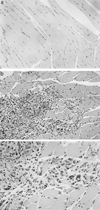Macrophage inflammatory protein-1alpha (MIP-1alpha) expression plasmid enhances DNA vaccine-induced immune response against HIV-1
- PMID: 9933462
- PMCID: PMC1905150
- DOI: 10.1046/j.1365-2249.1999.00793.x
Macrophage inflammatory protein-1alpha (MIP-1alpha) expression plasmid enhances DNA vaccine-induced immune response against HIV-1
Abstract
CD8+ cell-secreted CC-chemokines, MIP-1alpha, and MIP-beta have recently been identified as factors which suppress HIV. In this study we co-inoculated MIP-1alpha expression plasmid with a DNA vaccine constructed from HIV-1 pCMV160IIIB and pcREV, and evaluated the effect of the adjuvant on HIV-specific immune responses following intramuscular and intranasal immunization. The levels of both cytotoxic T lymphocyte (CTL) activity and DTH showed that HIV-specific cell-mediated immunity (CMI) was significantly enhanced by co-inoculation of the MIP-1alpha expression plasmid with the DNA vaccine compared with inoculation of the DNA vaccine alone. The HIV-specific serum IgG1/IgG2a ratio was significantly lowered when the plasmid was co-inoculated in both intramuscular and intranasal routes, suggesting a strong elicitation of the T helper (Th) 1-type response. When the MIP-1alpha expression plasmid was inoculated intramuscularly with the DNA vaccine, an infiltration of mononuclear cells was observed at the injection site. After intranasal administration, the level of mucosal secretory IgA antibody was markedly enhanced. These findings demonstrate that MIP-1alpha expression plasmid inoculated together with DNA vaccine acts as a strong adjuvant for eliciting Th1-derived immunity.
Figures




Similar articles
-
HIV-1-specific cell-mediated immunity is enhanced by co-inoculation of TCA3 expression plasmid with DNA vaccine.Immunology. 1997 Jan;90(1):1-6. doi: 10.1046/j.1365-2567.1997.00117.x. Immunology. 1997. PMID: 9038705 Free PMC article.
-
Topical application of HIV DNA vaccine with cytokine-expression plasmids induces strong antigen-specific immune responses.Vaccine. 2001 Oct 12;20(1-2):42-8. doi: 10.1016/s0264-410x(01)00324-3. Vaccine. 2001. PMID: 11567744
-
Novel engineered HIV-1 East African Clade-A gp160 plasmid construct induces strong humoral and cell-mediated immune responses in vivo.Virology. 2003 Sep 15;314(1):134-46. doi: 10.1016/s0042-6822(03)00459-8. Virology. 2003. PMID: 14517067
-
HIV-1 DNA vaccines.Immunol Lett. 1999 Jan;65(1-2):127-31. doi: 10.1016/s0165-2478(98)00135-7. Immunol Lett. 1999. PMID: 10065638 Review.
-
Facilitated DNA inoculation induces anti-HIV-1 immunity in vivo.Vaccine. 1994 Dec;12(16):1545-50. doi: 10.1016/0264-410x(94)90082-5. Vaccine. 1994. PMID: 7879423 Review.
Cited by
-
The catalytic A1 domains of cholera toxin and heat-labile enterotoxin are potent DNA adjuvants that evoke mixed Th1/Th17 cellular immune responses.Hum Vaccin Immunother. 2015;11(9):2228-40. doi: 10.1080/21645515.2015.1026498. Hum Vaccin Immunother. 2015. PMID: 26042527 Free PMC article.
-
Applications of chemokines as adjuvants for vaccine immunotherapy.Immunobiology. 2018 Jun-Jul;223(6-7):477-485. doi: 10.1016/j.imbio.2017.12.001. Epub 2017 Dec 8. Immunobiology. 2018. PMID: 29246401 Free PMC article. Review.
-
New Approaches to Dendritic Cell-Based Therapeutic Vaccines Against HIV-1 Infection.Front Immunol. 2022 Jan 4;12:719664. doi: 10.3389/fimmu.2021.719664. eCollection 2021. Front Immunol. 2022. PMID: 35058917 Free PMC article. Review.
-
Lactobacillus plantarum displaying CCL3 chemokine in fusion with HIV-1 Gag derived antigen causes increased recruitment of T cells.Microb Cell Fact. 2015 Oct 22;14:169. doi: 10.1186/s12934-015-0360-z. Microb Cell Fact. 2015. PMID: 26494531 Free PMC article.
-
Mucosal immunity: overcoming the barrier for induction of proximal responses.Immunol Res. 2004;30(1):35-71. doi: 10.1385/IR:30:1:035. Immunol Res. 2004. PMID: 15258310 Review.
References
-
- Davis HL, Michel ML, Whalen RG. Use of plasmid DNA for direct gene transfer and immunization. Ann NY Acad Sci. 1995;772:21–29. - PubMed
-
- Hassett DE, Whitton JL. DNA immunization. Trends Microbiol. 1996;4:307–12. - PubMed
-
- Kumar V, Szercar E. Genetic vaccination: the advantages of going naked. Nature Med. 1996;2:857–9. - PubMed
-
- Okuda K, Bukawa H, Hamajima K, et al. Induction of potent humoral and cell-mediated immune responses following direct injection of DNA encoding the HIV-1 env and rev gene products. AIDS Res Hum Retrovir. 1995;11:933–43. - PubMed
-
- Wang B, Boyer J, Srikantan V, et al. DNA inoculation induces neutralizing immune responses against human immunodeficiency virus type-1 in mice and nonhuman primates. DNA Cell Biol. 1993;12:799–05. - PubMed
Publication types
MeSH terms
Substances
LinkOut - more resources
Full Text Sources
Other Literature Sources
Research Materials
Miscellaneous

